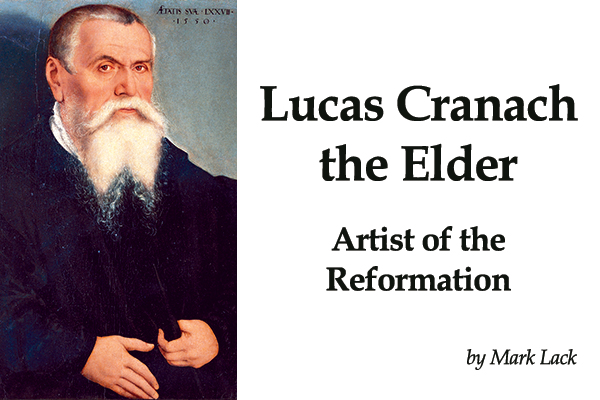Lucas Cranach the Elder

by Mark Lack
Martin Luther may have been condemned as a heretic by the Roman Church, but as he lay holed up in Wartburg Castle, he felt more like a hermit. In 1521, Luther had been declared an outlaw by the Holy Roman Emperor for refusing to recant his writings against the papacy. Luther’s life was in danger, and so under the protection of the Elector of Saxony, Frederick the Wise, he had gone into hiding at the Wartburg. Castle-bound for almost a year, the Reformer passed the time writing letters, preparing sermons, and translating the New Testament into German. Things were quiet in the Wartburg. They were not so quiet in Wittenberg; during Luther’s absence the Reformation had taken a radical turn. And so Luther’s good friend Lucas Cranach raised the alarm and got word to the Wartburg.
Cranach was concerned with Luther’s colleague Andreas Karlstadt, who, while denouncing ecclesial practices was introducing extreme reforms. Such reforms included the call for the removal of painted and carved images and decorative objects from churches. Fanatics would take it a step further, maliciously destroying these works of art. The iconoclasm controversy was one aspect of the Reformation that revealed that the movement was not always unified. Some reformers, like Karlstadt, insisted that the First Commandment’s prohibition of idolatry and the making and worshipping of graven images forbid religious imagery. But Luther was not convinced that God’s Word taught the same.
While Luther resisted the veneration of icons and images, he did not believe that their mere presence constituted blasphemy. The transgression only arose when they were used inappropriately. For Luther, works of art were not to become an object of trust and worship; but used rightly they can point us to the true object of trust and worship: Jesus Christ. Thus Luther perceived that pictorial art could serve the Gospel. Rather than abolish images, Luther understood their power to illustrate the Word and instruct the laity. He foresaw that the medium could help convey the message. And who better to aid in this effort than one of northern Europe’s most creative and accomplished artists—and who just happened to be plying his trade in Wittenberg—the aforementioned Cranach?
By the time Luther became acquainted with Lucas Cranach the Elder (1472-1553), the artist was well-established in Wittenberg as the painter to the Saxon Court. His many duties for Frederick had even included, ironically, preparing an earlier catalogue showcasing the Elector’s vast collection of religious relics. But as Cranach came to believe as Luther taught, he would use his extraordinary talents and the high art of the Renaissance to help propel the Reformation. It is by his skilled hands that we have come to know the likeness of Luther and the other leading figures of the German evangelical movement. Cranach’s portraits of Luther capture the Reformer’s steadfast determination but also his humility and piety.
As Cranach came to believe as Luther taught, he would use his extraordinary talents and the high art of the Renaissance to help propel the Reformation.
In addition to being known as the portraitist of the Reformation, Cranach is renowned for the artistry of his altarpieces. These powerful paintings are superb expressions of the Gospel, reflecting Luther’s teaching on sola fide and sola gratia, Law and Gospel, and Word and Sacrament. Cranach was also a master woodcarver and his work is often compared with that of the greatest German Renaissance artist, Albrecht Dürer. Cranach’s pioneering use of woodcuts in printing produced the beautifully detailed illustrations that adorned the pages of Luther’s German bible and the many tracts used to help spread the Good News of Jesus Christ.
Beyond their professional relationship, Cranach and Luther shared a deep personal friendship. Cranach served as the best man at the marriage of Luther and Katharina von Bora, and the two men were godfathers to one another’s children. Luther found in Cranach a kindred spirit who like him revelled in the pleasures of friends and family but whose faith was rooted in Christ.
As a sought-after artist, a successful businessman (he owned a pharmacy, a paper mill, and a publishing house), and a civic leader (he served three times as Wittenberg’s Bürgermeister), Cranach was a wealthy man. But he knew that true riches are found only in Christ; it is in Him alone that salvation lies.

The bottom panel of the altarpiece in St. Mary’s Church in Wittenberg. Luther preaches from the right while the congregation listens at left (Cranach the Elder stands in the back row at right). The focus of the painting, as of Luther’s preaching, is Christ. (Lucas Cranach the Elder, 1547).
This understanding is reflected in his altarpiece that today hangs in the City Church of Wittenberg. Rich in colour and content the magnificent media proclaims the evangelical message. Its bottom panel depicts Luther preaching to the congregation (with a cameo of Cranach himself). In one hand Luther holds an open bible, while with the other he points to the crucified Christ that graces the centre of the scene. It is an image that beautifully encapsulates the Lutheran understanding of the proper purpose of religious images—to point the viewer to the Saviour.
Cranach died on October 16, 1553. But his legacy of Christ-centered art continued on in the work of his son, Lucas Cranach the Younger. And it continues to this day in our churches too, whenever we see art that focuses our attention on the mercy of Christ. For that tradition, we are truly grateful for Lucas Cranach the Elder, and remember him with thanks.
———————
Mark Lack is a member of The Church of St. Mark–Lutheran in Mississauga, Ontario (a congregation of the LCMS). He is currently completing a Th.M. on Helmut Thielicke at the University of Toronto.
Banner image of Lucas Cranach the Elder by Lucas Cranach the Younger, 1549.




